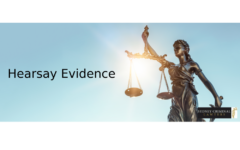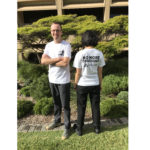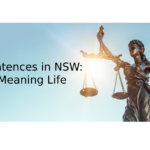What is Hearsay Evidence?

Hearsay is one of the most difficult and commonly misunderstood areas of evidence.
Many lawyers struggle to grasp the concept of hearsay and many magistrates struggle to apply it correctly.
This blog attempts to explain the laws of hearsay as they apply to criminal law.
The hearsay rule
Generally speaking, a person cannot give evidence about something that another person told them about what they directly observed.
This is called the ‘hearsay rule’.
The hearsay rule is contained in section 59 of the Evidence Act 1995 which states:
“Evidence of a previous representation made by a person is not admissible to prove the existence of a fact that it can reasonably be supposed that the person intended to assert by the representation.”
This is quite a convoluted explanation of the rule.
A simpler way to understand the rule is that, a person (X) can only give evidence as to what they themselves saw, heard or otherwise perceived.
For example, if another person (Y) saw a defendant (D) steal a car and then Y told X about it, X cannot give evidence to establish that the car was stolen.
X can only give evidence to establish what Y told him.
In essence, X’s evidence can be used to assert that a conversation took place between X and Y.
However, X’s evidence cannot be used to establish that D stole the car.
Exceptions to the hearsay rule
There are a number of exceptions to the hearsay rule.
Some are quite important, while others are less significant.
Here are the main exceptions:
Evidence relevant for non-hearsay purpose (s60)
This provision means that where a piece of hearsay evidence is given for a non-hearsay purpose, the hearsay rule does not apply to that piece of evidence.
For example, a witness may have made a statement before giving evidence in court.
If there is an inconsistency between the statement of the witness and what the witness says in court, the statement may be used to prove the truth of any facts contained in it.
This is also known as a ‘prior inconsistent statement’.
Maker unavailable (s65)
If a person who made a statement is unavailable in criminal proceedings, evidence that would ordinarily be inadmissible under the hearsay rule may be admissible in the following situations:
- If the maker of the statement was under a duty to make the statement, another person who saw, heard or otherwise perceived the statement being made may be able to give evidence.
- If the statement was made shortly after the asserted fact occurred and in circumstances where the asserted fact is unlikely to be false.
- If the statement is made in circumstances that make it highly probable to be reliable.
- If the statement was against the interests of the person who made it at the time that it was made and the circumstances make it likely that the statement was reliable.
Maker available (s66)
If the person who made the statement is available in criminal proceedings, the hearsay rule may be relaxed.
If another person heard, saw or otherwise perceived the representation, and the events are fresh in their memory, then that evidence will be admissible.
Tags and labels (s70)
The hearsay rule does not apply to tags and labels which describe the contents of objects or documents, and which were fixed to them in the course of a business.
Electronic communications (s71)
The hearsay rule does not apply to the identity of the sender, the date and time of the communication and the identity of the person/body to which the communication was sent.
Relationships and age (s73)
In a civil matter, the hearsay rule does not apply to evidence concerning whether a person is, or was at any time, married.
The hearsay rule also does not apply to a person’s age or their family history or family relationship.
In a criminal matter, this exception only applies if the defendant gives reasonable notice to the other parties, or if the evidence would contradict other admitted evidence.
Reputation of public or general rights (s74)
In criminal cases, hearsay evidence in relation to public or general rights can only be admitted by the prosecutor to contradict assertions by the defence.
Evidence in interlocutory proceedings (s75)
If a party can show evidence as to the source of a hearsay statement, this evidence will be admissible in interlocutory proceedings.
The above is a very brief and general description of the hearsay rule and its exceptions.
An experienced criminal defence lawyer will be able to quickly determine whether evidence is hearsay and whether any of the exceptions apply.
That analysis can often assist in getting criminal charges dropped at an early stage due to insufficient or unreliable evidence.
It can also assist defence lawyers to win cases in court if cases proceed to a defended hearing or jury trial.






